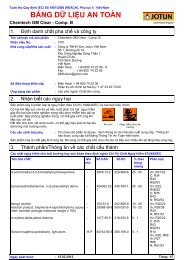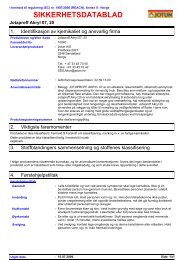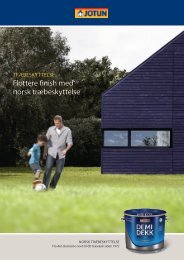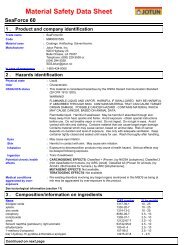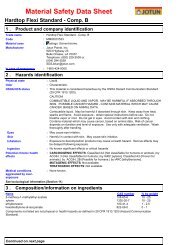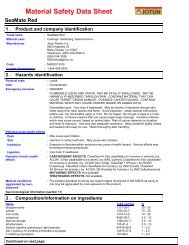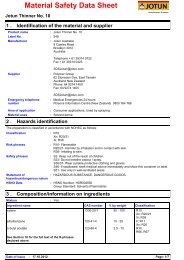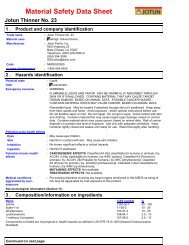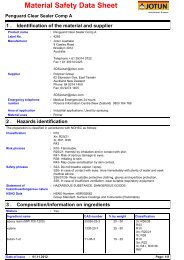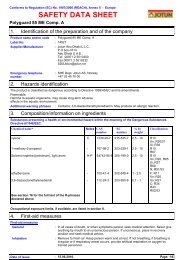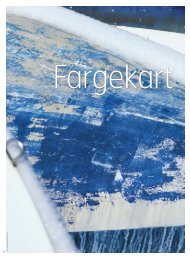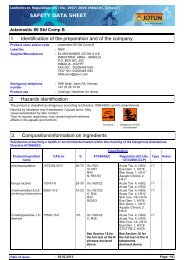SDS - Jotun Siloxane Acrylic Primer - Marine_Protective - English (uk)
SDS - Jotun Siloxane Acrylic Primer - Marine_Protective - English (uk)
SDS - Jotun Siloxane Acrylic Primer - Marine_Protective - English (uk)
- No tags were found...
Create successful ePaper yourself
Turn your PDF publications into a flip-book with our unique Google optimized e-Paper software.
This Safety Data Sheet is prepared in accordance with EU Directive 91/155/EC, as amended by Directive<br />
2001/58/EC - Europe<br />
SAFETY DATA SHEET<br />
<strong>Jotun</strong> <strong>Siloxane</strong> <strong>Acrylic</strong> <strong>Primer</strong><br />
1.<br />
Identification of the substance/preparation and company/undertaking<br />
Product name and/or code<br />
Supplier/Manufacturer<br />
: <strong>Jotun</strong> <strong>Siloxane</strong> <strong>Acrylic</strong> <strong>Primer</strong><br />
: <strong>Jotun</strong> Abu Dhabi L.L.C.<br />
P.O.box-3714<br />
Abu Dhabi U.A.E.<br />
Tel: 00971 2 5510300<br />
Fax:00971 2 5510232<br />
Emergency telephone number : <strong>Jotun</strong> Abu Dhabi L.L.C.: +971 2 5510300<br />
2.<br />
Composition/information on ingredients<br />
Chemical name*<br />
CAS no. EC number %<br />
Classification<br />
Naphtha (petroleum), hydrodesulfurized heavy 64742-82-1 265-185-4 25 - 50 R10<br />
Xn; R65<br />
R66, R67<br />
N; R51/53<br />
Solvent naphtha (petroleum), light arom. 64742-95-6 265-199-0 25 - 50 R10<br />
Xn; R20, R65<br />
Xi; R37<br />
R66<br />
N; R51/53<br />
See section 16 for the full text of the R-phrases declared<br />
above<br />
Occupational exposure limits, if available, are listed in section 8.<br />
3.<br />
Hazards identification<br />
The preparation is classified as dangerous according to Directive 1999/45/EC and its amendments.<br />
Flammable.<br />
Harmful by inhalation. Irritating to respiratory system.<br />
Toxic to aquatic organisms, may cause long-term adverse effects in<br />
the aquatic environment.<br />
Harmful<br />
Dangerous for the<br />
environment.<br />
4.<br />
First-aid measures<br />
First-aid measures<br />
General<br />
Inhalation<br />
Skin contact<br />
Eye contact<br />
Ingestion<br />
:<br />
:<br />
:<br />
:<br />
:<br />
In all cases of doubt, or when symptoms persist, seek medical attention. Never give anything by<br />
mouth to an unconscious person.<br />
Remove to fresh air. Keep person warm and at rest. If not breathing, if breathing is irregular or if<br />
respiratory arrest occurs, provide artificial respiration or oxygen by trained personnel. Give nothing by<br />
mouth. If unconscious, place in recovery position and seek medical advice.<br />
Remove contaminated clothing and shoes. Wash skin thoroughly with soap and water or use<br />
recognised skin cleanser. Do not use solvents or thinners.<br />
Check for and remove any contact lenses. Immediately flush eyes with running water for at least 15<br />
minutes, keeping eyelids open.<br />
If swallowed, seek medical advice immediately and show the container or label. Keep person warm<br />
and at rest. Do not induce vomiting.<br />
Date of issue : 04.05.2007. Page: 1/5
<strong>Jotun</strong> <strong>Siloxane</strong> <strong>Acrylic</strong> <strong>Primer</strong><br />
5.<br />
Fire-fighting measures<br />
Extinguishing media :<br />
Recommendations<br />
6. Accidental release measures<br />
Recommended: alcohol-resistant foam, CO2, powders, water spray.<br />
Not to be used : water jet.<br />
: Fire will produce dense black smoke. Exposure to decomposition products may cause a health<br />
hazard. Appropriate breathing apparatus may be required. Cool closed containers exposed to fire<br />
with water. Do not release runoff from fire to sewers or waterways.<br />
Personal precautions<br />
Spill<br />
:<br />
:<br />
Exclude sources of ignition and ventilate the area. Avoid breathing vapour or mist. Refer to<br />
protective measures listed in sections 7 and 8.<br />
Contain and collect spillage with non-combustible, absorbent material e.g. sand, earth, vermiculite or<br />
diatomaceous earth and place in container for disposal according to local regulations (see section<br />
13). Do not allow to enter drains or watercourses. Preferably clean with a detergent. Avoid using<br />
solvents. If the product contaminates lakes, rivers, or sewers, inform the appropriate authorities in<br />
accordance with local regulations.<br />
Note: see section 8 for personal protective equipment and section 13 for waste disposal.<br />
7.<br />
Handling and storage<br />
Handling<br />
Storage<br />
:<br />
:<br />
Vapours are heavier than air and may spread along floors. Vapours may form explosive mixtures<br />
with air. Prevent the creation of flammable or explosive concentrations of vapours in air and avoid<br />
vapour concentrations higher than the occupational exposure limits.<br />
In addition, the product should only be used in areas from which all naked lights and other sources of<br />
ignition have been excluded. Electrical equipment should be protected to the appropriate standard.<br />
To dissipate static electricity during transfer, earth drum and connect to receiving container with<br />
bonding strap. Operators should wear antistatic footwear and clothing and floors should be of the<br />
conducting type.<br />
Keep container tightly closed. Keep away from heat, sparks and flame. No sparking tools should be<br />
used.<br />
Avoid contact with skin and eyes. Avoid the inhalation of dust, particulates, spray or mist arising from<br />
the application of this preparation. Avoid inhalation of dust from sanding.<br />
Eating, drinking and smoking should be prohibited in areas where this material is handled, stored<br />
and processed. Workers should wash hands and face before eating, drinking and smoking.<br />
Put on appropriate personal protective equipment (see section 8).<br />
Never use pressure to empty. Container is not a pressure vessel. Always keep in containers made<br />
from the same material as the original one.<br />
Comply with the health and safety at work laws.<br />
When operators, whether spraying or not, have to work inside the spray booth, ventilation is unlikely<br />
to be sufficient to control particulates and solvent vapour in all cases. In such circumstances they<br />
should wear a compressed air-fed respirator during the spraying process and until such time as the<br />
particulates and solvent vapour concentration has fallen below the exposure limits.<br />
Store in accordance with local regulations. Observe label precautions. Store in a cool, well-ventilated<br />
area away from incompatible materials and ignition sources.<br />
Keep away from: oxidising agents, strong alkalis, strong acids.<br />
No smoking. Prevent unauthorised access. Containers that have been opened must be carefully<br />
resealed and kept upright to prevent leakage.<br />
Do not empty into drains.<br />
8. Exposure controls/personal protection<br />
Engineering measures<br />
Ingredient name<br />
:<br />
Provide adequate ventilation. Where reasonably practicable, this should be achieved by the use of<br />
local exhaust ventilation and good general extraction. If these are not sufficient to maintain<br />
concentrations of particulates and solvent vapours below the OEL, suitable respiratory protection<br />
must be worn.<br />
Occupational exposure limits<br />
Date of issue : 04.05.2007. Page: 2/5
<strong>Jotun</strong> <strong>Siloxane</strong> <strong>Acrylic</strong> <strong>Primer</strong><br />
Naphtha (petroleum), hydrodesulfurized<br />
heavy<br />
ACGIH TLV (United States, 1/2005). Notes: Substances for which the TLV is<br />
higher than the OSHA Permissible Exposure Limit (PEL) and/or the NIOSH<br />
Recommended Exposure Limit (REL). See CFR 58(124) :36338-33351, June 30,<br />
1993, for revised OSHA PEL.<br />
TWA: 525 mg/m³ 8 hour(s). Form: All forms<br />
TWA: 100 ppm 8 hour(s). Form: All forms<br />
Solvent naphtha (petroleum), light arom. EU OEL (Europe, 6/2000).<br />
TWA: 100 mg/m³ 8 hour(s). Form: All forms<br />
TWA: 20 ppm 8 hour(s). Form: All forms<br />
Personal protective equipment<br />
Respiratory system<br />
Skin and body<br />
Hands<br />
: If workers are exposed to concentrations above the exposure limit, they must use appropriate,<br />
certified respirators. Use respiratory mask with charcoal and dust filter when spraying this<br />
product.(as filter combination A2-P2).In confined spaces, use compressed-air or fresh-air<br />
respiratory equipment.When use of roller or brush, consider use of charcoalfilter.<br />
: Personnel should wear antistatic clothing made of natural fibres or of high-temperature-resistant<br />
synthetic fibres.<br />
:<br />
For prolonged or repeated handling, use the following type of gloves: gloves: polyvinyl alcohol or<br />
nitrile.<br />
Eyes<br />
:<br />
Barrier creams may help to protect the exposed areas of the skin but should not be applied once<br />
exposure has occurred.<br />
For right choice of glove materials, with focus on chemical resistance and time of penetration, seek<br />
advice by the supplier of chemical resistant gloves.<br />
Use safety eyewear designed to protect against splash of liquids.<br />
9.<br />
Physical and chemical properties<br />
Physical state<br />
Odour<br />
Colour<br />
:<br />
:<br />
:<br />
Liquid.<br />
Characteristic.<br />
Various<br />
Flash point<br />
: Closed cup: 35°C (95°F)<br />
Density : 0.84 g/cm 3<br />
Solubility<br />
: Insoluble in the following materials: cold water and hot water.<br />
10.<br />
Stability and reactivity<br />
Stable under recommended storage and handling conditions (see section 7).<br />
Hazardous decomposition products: carbon monoxide, carbon dioxide, smoke, oxides of nitrogen.<br />
Keep away from the following materials to prevent strong exothermic reactions: oxidising agents, strong alkalis, strong acids.<br />
11.<br />
Toxicological information<br />
There is no data available on the preparation itself. The preparation has been assessed following the conventional method of the<br />
Dangerous Preparations Directive 1999/45/EC and classified for toxicological hazards accordingly. See sections 2 and 15 for details.<br />
Exposure to component solvent vapour concentrations in excess of the stated occupational exposure limit may result in adverse<br />
health effects such as mucous membrane and respiratory system irritation and adverse effects on the kidneys, liver and central<br />
nervous system. Solvents may cause some of the above effects by absorption through the skin. Symptoms and signs include<br />
headache, dizziness, fatigue, muscular weakness, drowsiness and, in extreme cases, loss of consciousness. Repeated or prolonged<br />
contact with the preparation may cause removal of natural fat from the skin, resulting in non-allergic contact dermatitis and<br />
absorption through the skin. If splashed in the eyes, the liquid may cause irritation and reversible damage.<br />
12.<br />
Ecological information<br />
There is no data available on the preparation itself.<br />
Do not allow to enter drains or watercourses.<br />
The preparation has been assessed following the conventional method of the Dangerous Preparations Directive 1999/45/EC and is<br />
classified for eco-toxicological properties accordingly. See Sections 2 and 15 for details.<br />
Ecotoxicity data<br />
Ingredient name<br />
Species Period Result<br />
Date of issue : 04.05.2007. Page: 3/5
<strong>Jotun</strong> <strong>Siloxane</strong> <strong>Acrylic</strong> <strong>Primer</strong><br />
Naphtha (petroleum), hydrodesulfurized heavy<br />
Solvent naphtha (petroleum), light arom.<br />
Fish (LC50)<br />
Daphnia (EC50)<br />
Algae (IC50)<br />
Fish (LC50)<br />
Daphnia (EC50)<br />
Algae (IC50)<br />
96 hour(s)<br />
48 hour(s)<br />
72 hour(s)<br />
96 hour(s)<br />
48 hour(s)<br />
72 hour(s)<br />
<strong>Jotun</strong> <strong>Siloxane</strong> <strong>Acrylic</strong> <strong>Primer</strong><br />
16.<br />
Other information<br />
CEPE Classification : 1<br />
Full text of R-phrases referred<br />
to in sections 2 and 3 - Europe<br />
Notice to reader<br />
History<br />
Date of printing<br />
Date of issue<br />
Version<br />
Prepared by<br />
: R10- Flammable.<br />
R20- Harmful by inhalation.<br />
R65- Harmful: may cause lung damage if swallowed.<br />
R37- Irritating to respiratory system.<br />
R66- Repeated exposure may cause skin dryness or cracking.<br />
R67- Vapours may cause drowsiness and dizziness.<br />
R51/53- Toxic to aquatic organisms, may cause long-term adverse effects in the aquatic<br />
environment.<br />
: 04.05.2007.<br />
: 04.05.2007.<br />
: 1<br />
: <strong>Jotun</strong> Group Product Safety Department<br />
The information in this <strong>SDS</strong> is based on the present state of our knowledge and on current laws. The product is not to be used for purposes<br />
other than those specified under section 1 without first obtaining written handling instructions. It is always the responsibility of the user to<br />
take all necessary steps to fulfil the demands set out in the local rules and legislation. The information in this <strong>SDS</strong> is meant to be a description<br />
of the safety requirements for our product. It is not to be considered a guarantee of the product's properties.<br />
Indicates information that has changed from previously issued version.<br />
Version<br />
1<br />
Page: 5/5



